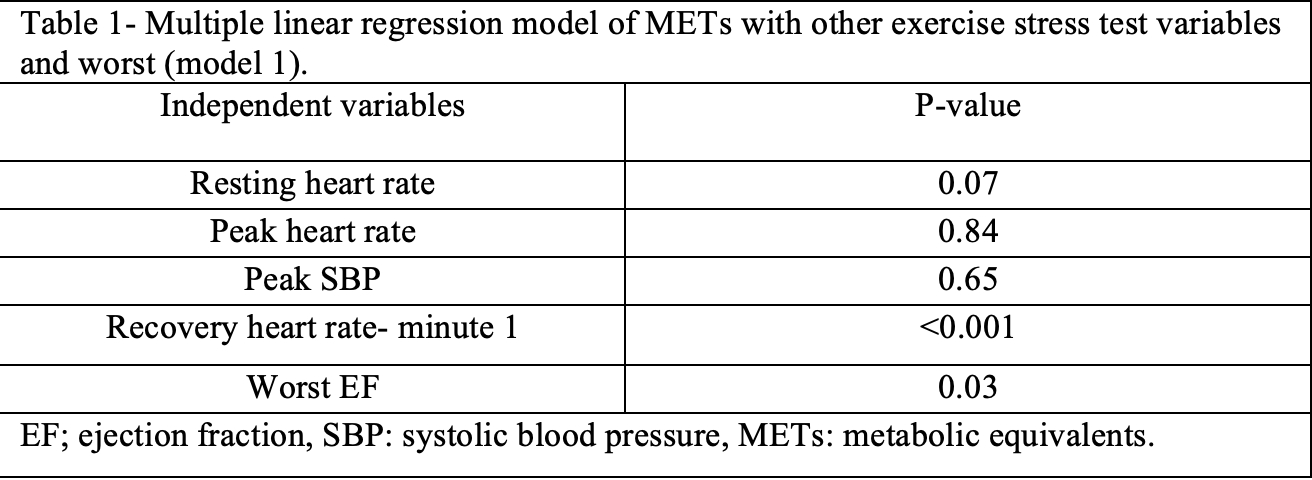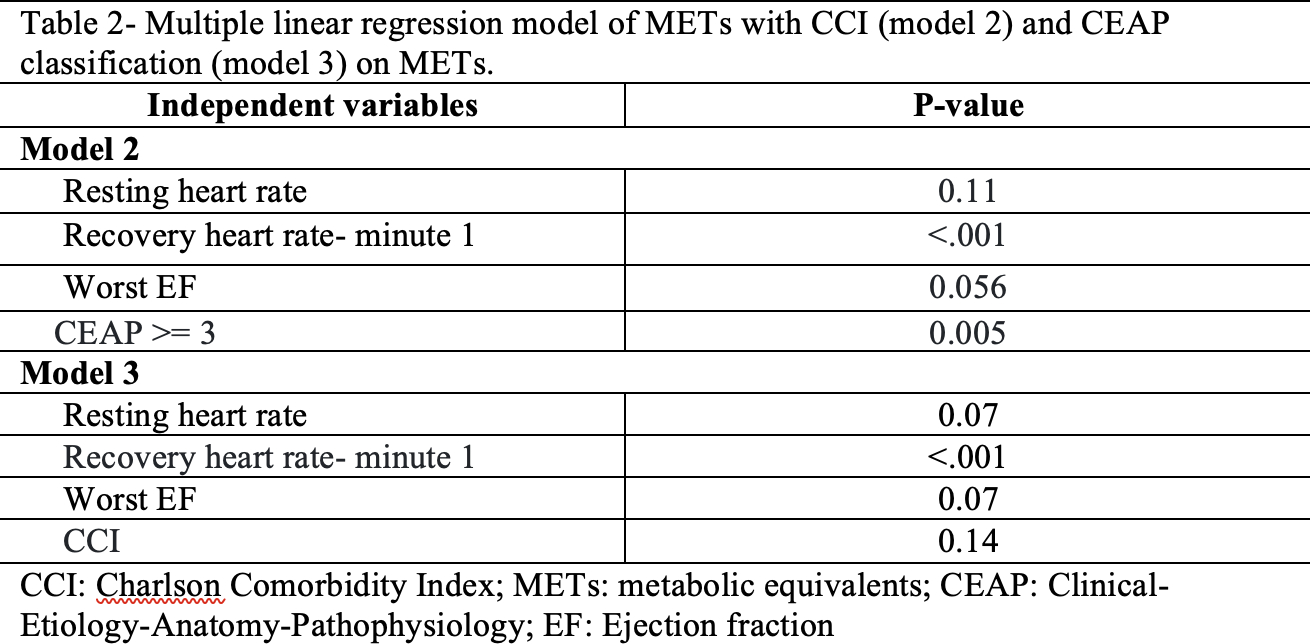Final ID: MDP150
Relationship Between Calf Muscle Pump Function and Exercise Stress Testing
Abstract Body (Do not enter title and authors here): Background
Exercise stress testing uses metabolic equivalents of tasks (METs) to measure the energy cost of activities, aiding in the assessment of exercise capacity and cardiovascular health. Despite its significance, the correlation between calf muscle pump function (CPF) and exercise stress testing remains unexplored. We aimed to evaluate the relationship between CPF and peak METs as determined by cardiopulmonary treadmill exercise stress testing.
Methods
The study included adults who underwent exercise cardiopulmonary stress testing and venous plethysmography at Mayo Clinic between April 2017 and March 2020. The protocols other than Bruce, Mayo, Modified Naughton, and Naughton protocols were excluded. The CPF ejection fraction (EF) was calculated per leg based on refill volumes post-exercise as a percentage of passive drain refill. The classification of CEAP (Clinical-Etiology-Anatomy-Pathophysiology) was utilized to better understand chronic venous insufficiency (CVI).
Results
A total of 155 patients who underwent both exercise stress testing and venous plethysmography were included, with a mean age of 61.31 ± 14.03 years, and 84 (54.2%) were male. The peak measured METs for normal, unilaterally reduced, and bilaterally reduced CPF were 8.5 (2.5), 7.3 (2.1), and 7.1 (2.4), respectively (p=0.004, Figure 1). Multiple linear regression models were developed with METs as the outcome to determine if CPF was an independent predictor of METs on cardiopulmonary exercise stress testing. IIn model 1, the following independent variables were included: resting heart rate, peak heart rate, peak systolic blood pressure, recovery heart rate at minute 1, and worst EF (Table 1). In model 1, with only exercise parameters, lower EF was associated with lower METs (p=0.03). In a second analysis, variables identified as statistically significant with METs in the initial model were included, along with CEAP class (model 2) and CCI (model 3) (Table 2). In model 2, CEAP class 3 or higher was associated with decreased METs on the exercise stress test. This correlation implies that individuals with moderate to severe CVI may influence exercise capacity, demonstrating the interconnectedness of the cardiovascular system. Moreover, in model 3, the CCI, a predictor for mortality, was not significantly associated with METs.
Conclusion
Our findings revealed that more severe CVI (CEAP class and reduced CPF) was associated with reduced exercise capacity after accounting for other factors.
Exercise stress testing uses metabolic equivalents of tasks (METs) to measure the energy cost of activities, aiding in the assessment of exercise capacity and cardiovascular health. Despite its significance, the correlation between calf muscle pump function (CPF) and exercise stress testing remains unexplored. We aimed to evaluate the relationship between CPF and peak METs as determined by cardiopulmonary treadmill exercise stress testing.
Methods
The study included adults who underwent exercise cardiopulmonary stress testing and venous plethysmography at Mayo Clinic between April 2017 and March 2020. The protocols other than Bruce, Mayo, Modified Naughton, and Naughton protocols were excluded. The CPF ejection fraction (EF) was calculated per leg based on refill volumes post-exercise as a percentage of passive drain refill. The classification of CEAP (Clinical-Etiology-Anatomy-Pathophysiology) was utilized to better understand chronic venous insufficiency (CVI).
Results
A total of 155 patients who underwent both exercise stress testing and venous plethysmography were included, with a mean age of 61.31 ± 14.03 years, and 84 (54.2%) were male. The peak measured METs for normal, unilaterally reduced, and bilaterally reduced CPF were 8.5 (2.5), 7.3 (2.1), and 7.1 (2.4), respectively (p=0.004, Figure 1). Multiple linear regression models were developed with METs as the outcome to determine if CPF was an independent predictor of METs on cardiopulmonary exercise stress testing. IIn model 1, the following independent variables were included: resting heart rate, peak heart rate, peak systolic blood pressure, recovery heart rate at minute 1, and worst EF (Table 1). In model 1, with only exercise parameters, lower EF was associated with lower METs (p=0.03). In a second analysis, variables identified as statistically significant with METs in the initial model were included, along with CEAP class (model 2) and CCI (model 3) (Table 2). In model 2, CEAP class 3 or higher was associated with decreased METs on the exercise stress test. This correlation implies that individuals with moderate to severe CVI may influence exercise capacity, demonstrating the interconnectedness of the cardiovascular system. Moreover, in model 3, the CCI, a predictor for mortality, was not significantly associated with METs.
Conclusion
Our findings revealed that more severe CVI (CEAP class and reduced CPF) was associated with reduced exercise capacity after accounting for other factors.
More abstracts on this topic:
A KLF2-BMPER-Smad1/5 checkpoint regulates high fluid shear stress-mediated artery remodeling
Deng Hanqiang, Zhang Jiasheng, Schwartz Martin
Association Between Lp(a) and Cardiovascular Events in Individuals with Peripheral Artery Disease in the Mass General Brigham Lp(a) RegistryMcclintick Daniel, Gerhard Marie, Januzzi James, Di Carli Marcelo, Secemsky Eric, Bhatt Deepak, Blankstein Ron, Divakaran Sanjay, Biery David, Berman Adam, Besser Stephanie, Shiyovich Arthur, Singh Avinainder, Huck Daniel, Weber Brittany, Bonaca Marc



